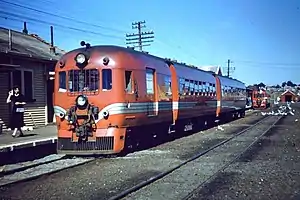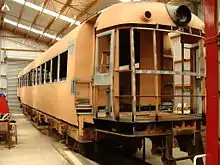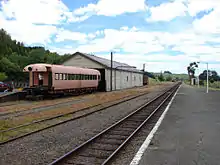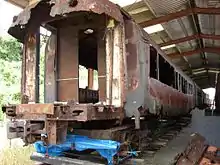NZR RM class (88 seater)
The NZR RM class 88-seaters were a class of railcar used in New Zealand. New Zealand Government Railways (NZR) classed them RM (Rail Motor), the notation used for all railcars, numbering the 35 sets from RM100 to RM134. They were the most numerous railcars in NZR service,[1] and were known unofficially as "Articulated", "Eighty Eights",[2] "Twinsets",[3] "Drewrys"[1] or "Fiats".[4] Their purchase and introduction saw the demise of steam-hauled provincial passenger trains and mixed trains.[1]
| NZR RM class Articulated 88-seater | |
|---|---|
 88-seater railcar RM 114 at Kaikoura Railway Station during the 1960s. | |
| In service | 1955–1978 |
| Manufacturer | Drewry Car Co, England |
| Built at | Birmingham Railway Carriage & Wagon Co, Smethwick, UK |
| Entered service | 1955–1958 |
| Scrapped | 1978 |
| Number built | 35 |
| Number in service | 0 |
| Number scrapped | 33.5 |
| Formation | No 1 end (36 passengers & luggage compartment) articulated over a Jacobs bogie with No 2 end (52 passengers) |
| Fleet numbers | RM 100 – RM 134 |
| Capacity | 88 passengers |
| Operator(s) | New Zealand Railways |
| Line(s) served | Many main and branch lines |
| Specifications | |
| Train length | 105 ft (32.00 m) total |
| Width | 8 ft 10 in (2.69 m) |
| Maximum speed | 65 mph (105 km/h) |
| Weight | 63.1 long tons (64.1 t; 70.7 short tons) |
| Prime mover(s) | Two Fiat 700.040, six cylinder, horizontal underfloor, 1500 rpm naturally aspirated |
| Power output | 420 hp (310 kW) total (original) 370 hp (280 kW) (derated) |
| Transmission | Wilson 5-speed gearbox (per engine) |
| UIC classification | Bo–2–Bo |
| Track gauge | 3 ft 6 in (1,067 mm) |
Introduction
In the early 1950s, New Zealand Railways (NZR) was in the process of replacing steam traction with diesel and modernising the railways to cope with vastly increased traffic, the after-effects of wartime stringency, and increasing competition from motor vehicles and aeroplanes. Drewery presented a design for an articulated railcar with seating for 88 passengers. The use of horizontal underfloor diesel engines allowed increased passenger capacity and allowed for a large parcels and baggage compartment. Fiat 210 hp (160 kW) engines were selected.
As part of this modernisation process, it was decided to upgrade provincial passenger services, which were provided by a combination of steam-hauled passenger trains that operated several times a week, and "mixed" trains that carried both freight and passengers. An order was placed with the Drewry Car Company in the United Kingdom in March 1950,[5] which had supplied some smaller diesel shunters to NZR previously. The railcars were constructed by the Birmingham Railway Carriage and Wagon Company under contract from Drewry. There were significant delays in delivering the railcars, with one damaged in transit.[2] The first railcar was delivered in November 1954[2] and the last in May 1958.[6]
The bogie and running gear design had been closely supervised by NZR Chief Mechanical Engineer R.F. (Bob) Black,[7] and while there was significant sway at speed, it was nowhere as bad as the movement of the older Vulcan and Standard railcars cornering at speed. Unfortunately, the design of the power train could not be supervised.[8]
Following their introduction, the railcars suffered overheating from ballast dust[2] and engine failure which led to railcars running 20 to 30 minutes late every two to three days and frequent internal and external fires on surrounding farmland and foliage, due to excessive carbon in the exhaust emissions, notably on the steep West Coast railway lines and the steep Scargill and Dashwood banks on the Picton line.[9] The crankcases were not strong enough to absorb the power of the two 210 hp Fiat engines that drove the railcars. Ten of the railcars had wrecked crankcases[10] and blown motors a number of extra replacement motors and crankcases had to be ordered in 1956–57 and in 1958–59. Fiat staff and fitters from Italy came to New Zealand and essentially rebuilt the engines and power systems of all the railcars.[11] The rebuilding was completed in March 1959, and the Minister reported that the railcars were giving "much better service" as a result.[2]
In service
After initial trials around Wellington, the railcars were deployed on a wide variety of provincial services. In the North Island they ran Auckland – Okaihau, Auckland – Te Puke, Auckland – Rotorua, Auckland – New Plymouth, Wellington – Palmerston North via Masterton, and Wellington – Gisborne.
In early December 1955, NZR ran a four-day demonstration train from Picton to Invercargill, creating much public interest.[12] In the South Island they ran Christchurch – Picton, Christchurch – Invercargill, and in conjunction with the Vulcan class, Christchurch – Greymouth and Ross.
Second batch
The 1952 Royal Commission recommended railcar services between Auckland and Wellington and replacing the daylight stopping train on the Christchurch-Dunedin route (which supplemented the South Island Limited and other fast express services) leaving Dunedin at 8:05 am and Christchurch at 9:40 am on Monday, Wednesday and Friday and replace local trains between Auckland and Hamilton, Wellington and Palmerston North, Christchurch and Ashburton.[13]
The second batch of 15 railcars were authorised by the government in October 1955,[14] but cancelled in 1957 due to the unsatisfactory performance of the railcars and their high cost in repairs and the skilled labour diverted, particularly in Auckland.[15]
Operation
From almost the beginning the railcars faced mechanical problems, with cooling being the primary issue,[1] along with crankcase failures and electrical fires towards the end of their lives.[1] Although modifications were made they continued to have a reputation for unreliability throughout their career, frequently having to run with one motor isolated.
The 1950s was a period of increased prosperity and saw massive increases in the numbers of private motorcars, along with improvements to roading such as tar sealing of main highways, and the construction of new roads such as the Auckland Harbour Bridge. While the delay in introducing the railcars on the Rotorua route (1959) and the difficult geography of the Northland and Bay of Plenty service meant poor patronage, the railcars stabilised NZRs long-distance rail patronage at 3 million passengers annually from 1959–1964.[1] But by the mid-1960s the railcars were dated, patronage fell and services became unprofitable.[1]
NZR requested the calling of tenders for new engines and crankshafts for all 35 railcars plus spares for £1.05 million pounds in July 1966.[16][17] In January 1967 the Cabinet approved only replacement crankshafts to continue the railcars for five years on the Wairarapa, Wellington-Napier-Gisborne and Auckland-New Plymouth routes[18] and to conduct trials of fast upgraded railcar service between Auckland and Hamilton (later known as the "Blue Streak" service) and Wellington and Palmerston North. At the time it was intended to scrap all railcar operation in the South Island, except for Vulcans on the Picton (Vulcan railcars and summer passenger trains replaced the 88-seaters on this route from 1967–1968) and West Coast services.
From 31 July 1967 all railcar services between Auckland and Northland were cancelled, along with services from Auckland and Hamilton to Tauranga and Te Puke.[19] The railcar service to New Plymouth was kept but was cut back to operate between New Plymouth and Taumarunui in 1971, with passengers making connections to North Island Main Trunk trains.[20] This service lasted until 11 February 1978 when it was replaced by a carriage train.[20] The final run of an 88-seater railcar was in 1978 from Greymouth to Christchurch. The last trip came to an ignominious end when an engine failure and fire meant that passengers had to be taken onwards from Otira by bus.
Almost all cancelled trains were replaced by New Zealand Railways Road Services buses.
Withdrawals
In 1976 it was announced that no more railcars would receive major overhaul works, and they would be withdrawn from service as they wore out.[21] Although the remaining services were to areas not well served by road, the mechanical condition of the railcars meant that by the mid-1970s replacement was becoming urgent.[22] By 1978, the only remaining railcars in NZR service were the Silver Ferns.[6]
Grassgrubs
It was decided to refurbish 14 railcars, remove their engines and drivers' cabs, and convert them to what was known as AC class unpowered carriages.[6] These carriages were painted a unique grass green with grey roofs and came to be known as "Grassgrubs".[23] They ran on the New Plymouth to Taumarunui, a reintroduced Napier to Gisborne service, Wellington to Palmerston North via the Wairarapa, Picton to Christchurch, and Christchurch to Greymouth services.
The Grassgrubs were ill-fated. Their drawgear and bodies were not designed to be locomotive-hauled and they quickly wore out. By 1985 they had all been withdrawn from service due to metal fatigue. Most of the passenger runs were continued after their demise, but the New Plymouth-Taumarunui service ended in 1983 (having already had its rolling-stock replaced by [[NZR 56-foot carriage|56-foot carriages.] They also ran for a time between Wellington to Gisborne. (This service eventually terminated at Napier following Cyclone Bola in March 1988. By the late 1980s, the Wellington-Wairarapa service was abbreviated to terminate in Masterton as patronage on the Masterton – Palmerston North section was often fewer than 20 passengers per trip, due to improved highways and bus services. The AC class vehicles were replaced by 56-foot carriages on the remaining Wellington-Gisborne, Picton-Christchurch, Wairarapa and Christchurch-Greymouth services.
Blue Streaks

In 1968, at the suggestion of Hamilton City Council, an 88-seater was refurbished for a new fast service between Hamilton and Auckland aimed at business customers, and it started on Monday, 8 April 1968.[24] It was fitted with carpet and re-upholstered fabric-covered seats, and was painted in a new two-tone blue colour scheme that prompted the nickname Blue Streak. The seating was reduced to 84 to accommodate a servery area from which light meals and assorted alcoholic and non-alcoholic drinks could be purchased. This was notable as the first time that a regularly scheduled passenger train service in New Zealand had reinstated onboard catering since dining cars had been withdrawn across the network as an economy measure during World War I. This initial service was unsuccessful, with patronage well below the levels needed to be profitable. The service might have been successful if run the other way round from Hamilton to Auckland in the morning but in 1968 the Wellington-Auckland Limited and Express were still timetabled to cater for the early morning commuter market from Hamilton and Huntly or in the other direction from Palmerston North and Levin and those leaving Auckland or Wellington in the evening for the Waikato or Manawatu or Horowhenua, while the NZR long term desire to maintain the New Plymouth- Auckland railcar service was much more because it brought people into Auckland in the morning, leaving Taumarunui at 6.30 am and Hamilton at 9.30am and returned in the afternoon rather than for its night social and paper service through the King Country which Government saw as essential. Therefore, the Hamilton commuter market was served by many other services at lower second class fare cost in 1968 and the Blue Streak experiment was simply in the wrong direction at the wrong time.
It was decided to introduce the railcar to a daytime service between Auckland and Wellington. This service, which started on Monday 23 September 1968, was highly successful and prompted the conversion of two further cars to 82 seats each to accommodate larger servery areas and, later, the purchase of the Silver Fern diesel-electric railcars for this service.[24]
Initially, the Main Trunk Blue Streak railcar ran from Wellington to Auckland on Mondays, Wednesdays and Fridays and on Tuesdays and Thursdays from Auckland to Wellington until a second railcar was refurbished for the Christmas 1968 and New Year 1969 period and a third for the 1969 Easter holidays.[24] The service proved so popular that it was not uncommon to see two of the railcars running in multiple.
On Thursday 18 December 1972,[1] the Blue Streak services were replaced by the new Silver Fern railcars and were transferred to the Wellington-to-New Plymouth service, replacing Standard railcars. They continued in this service until Friday 30 July 1977.[1] By that time they were no longer serviceable, patronage had continued to decline and the service was replaced with buses.[6]
Preservation



Following withdrawal from service, a number of the 88 seaters were stored around the country. Several units along with a Vulcan railcar were sold to the Southern Rail preservation project at Christchurch where they were later scrapped; the cab and baggage car section of the No.1 end of RM 119 on the leading bogie together with some engines and gearboxes were kept at this time. After the project was wound up, the partial section of RM 119 was moved to Linwood Locomotive Depot where it remained in storage for several years. Subsequently, the further abbreviated RM 119 consisting of just the cab and part of the baggage compartment was stored in a Bromley scrapyard, where it was found and purchased by the RM 133 Trust Board.[3]
By the early 1990s, the only known survivor was RM 133 in its "Grassgrub" form as AC 8140, used for fire training at Auckland Airport. In 2001 the RM 133 Trust Board was able to obtain this car, which was later found to be the No 1 end of RM 133 and the No 2 end of RM 115. Before the railcar could be removed a fire broke out in the No 2 half of the railcar, damaging the body. The RM 133 Trust decided to look for any other extant railcar halves to pair with the No 1 end of RM 133, which had been moved to the Pahiatua Railcar Society's site.
In late 2002, the trust located the No 2 end of RM 121 in a quarry at Kerikeri. Although the car was in a weathered condition and had been cut in half at some point, it was still relatively complete despite missing the seats, bogies (removed in the late 1970s at Otahuhu Workshops), and its diesel engines. This railcar was purchased to become the replacement for the damaged half of RM 133 and moved to Pahiatua where restoration work began. The other half of RM 121 had been separated in the mid-1980s after the railcars were used as offices at a former theme park in the Auckland area and had ended up at a holiday camp in Waitomo. The Trust negotiated with the owners to buy the car body and were eventually able to purchase the car in 2011 in exchange for two former wooden passenger cars. The No 1 end of RM 121 was then trucked to Pahiatua to be reunited with the No 2 end at Pahiatua.[25]
The two halves of RM 121 are now being restored at Pahiatua; the two halves of the No 2 end have been welded together again and a new cab structure and cowcatcher built. The No 1 end has been stripped of any fittings from its time spent at Waitomo and various reconstruction work is taking place. The resultant car will utilise the bogies from AC 8140.[3]
The remnants of the No 1 end of RM 133 and the No 2 end of RM 115 as AC 8140 are in covered storage at Pahiatua.
Notes
- Bromby 2003, p. 124.
- Leitch & Stott 1988, p. 115.
- "Drewry Twinsets". Pahiatua Railcar Society Incorporated. 2 February 2020.
- Churchman & Hurst 2001, p. 47.
- Miles 1995, p. 7.
- Churchman & Hurst 2001, p. 52.
- NZR CME Black to NZR GM 8-3-1957
- R.F. Black
- Acting DME Christchurch to CME 11/2/1957
- R.F. Black 8-3-1957
- Alan Gandell, NZR General Manager to Minister of Railways, John McAlpine, 28-7-1966. National Archives
- Leitch & Stott 1988, p. 116.
- Christchurch DME and DTM to CME and Transport Superintendent 18-7-55 and 22-9-55 decided on two return runs Christchurch to Ashburton and rejected the planned extension of local railcar service to Timaru on basis of historical patronage and size and distribution of South Canterbury's population
- R.F. Black 7/10/55 NZ National Archives- file twin set railcars 1955 34/280 A
- Acting CME 8-3-1966 noted that 20% of the fitters at Auckland railway workshops were employed on railcar servicing, while the railcars were only 7.5% of the fleet and 2.5% of the available traction by horsepower. NZR general manager Alan Gandell in the 28-7-66 paper (National Archives-Mulgrave St, Wgtn) arguing for ordering different engines for the railcars "A grade" overhauls took 40 days in Auckland, 26/27 days in Wellington and Christchurch
- Alan Gandell NZR General Manager to Minister of Railways 28-7-1966
- CME NZR 5-12-1966 to Adv Engineer, NZ High Comm London and reply 7/12/66 CME to RR on proposal of using Rolls Royce 6 cylinder supercharged engines to re-engine the railcars
- Ivan Thomas NZR GM on 13-3-1967 releases Cabinet 30/1/67 decision to reject the calling of tenders to re-engine the railcars and schedule of progressive route abandonment to phase them out over 5 years
- T. A. McGavin (Spring 1967). "Railcars No More to Whangarei, Tauranga or Westport". New Zealand Railway Observer. New Zealand Railway and Locomotive Society. 24 (113): 88. ISSN 0028-8624.
- Churchman & Hurst 2001, p. 144.
- "More Railcar Services Curtailed". New Zealand Railway Observer. New Zealand Railway and Locomotive Society. 33 (146): 76. Winter 1976. ISSN 0028-8624.
- "Why the Railcars Had to Go". Rails: 16-17. July 1976. ISSN 0110-6155.
- Churchman & Hurst 2001, p. 141.
- Churchman & Hurst 2001, p. 46.
- Eastwood, Tamara (1 September 2011). "Half railcar pulls up". Wairarapa Times-Age. Masterton: APN Holdings NZ. Archived from the original on 28 March 2012. Retrieved 2 September 2011.
References
- Bromby, Robin (2003). Rails that built a Nation: An Encyclopaedia of New Zealand Railways. Wellington: Grantham House. ISBN 1-86934-080-9.
- Churchman, Geoffrey B; Hurst, Tony (2001) [1990, 1991]. The Railways of New Zealand: A Journey through History (Second ed.). Transpress New Zealand. ISBN 0-908876-20-3.
- Heath, Eric; Stott, Bob (1993). Classic Railcars, Electric and Diesel Locomotives Of New Zealand. Grantham House. ISBN 1869340418.
- Churchman, Geoffrey (1989). The Golden Era of Fiat Railcars in New Zealand. IPL Publishing. ISBN 0959783245.
- Miles, Robert (1995). The End of the New Zealand Passenger Train. Beynon Printing Company. p. 32. ISBN 0473033208.
- Leitch, David; Stott, Bob (1988). New Zealand Railways: The First 125 Years. Auckland: Heinemann Reed. p. 176. ISBN 0-7900-0000-8.